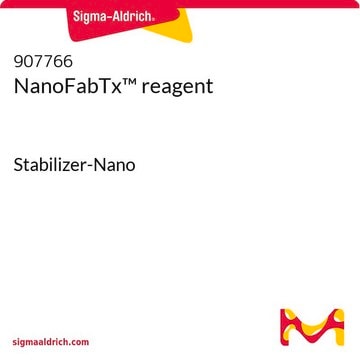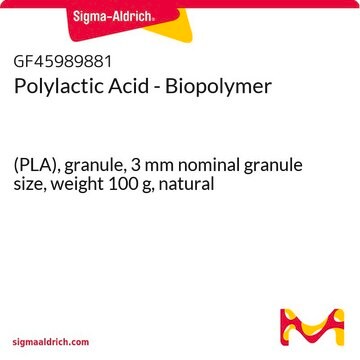918075
NanoFabTx™ PLA-nano
for synthesis of 100 and 200 nm particles
Synonim(y):
For nanoparticle synthesis for drug delivery
About This Item
Polecane produkty
Opis ogólny
- A nanoprecipitation protocol to prepare drug-encapsulated nanoparticles in standard laboratory glassware.
- A microfluidics protocol using commercial platforms or syringe pumps.
Zastosowanie
Cechy i korzyści
- Ready-to-use nanoformulation kit for PLA nanoparticles
- Step-by-step protocols developed and tested by our formulation scientists
- Flexible synthesis tool to create uniform and reproducible nanoparticles
- Optimized to make nanoparticles 100–200 nm nanoprecipitation or microfluidics with low polydispersity
- Based on non-toxic, biodegradable polymers
Informacje prawne
produkt powiązany
Kod klasy składowania
11 - Combustible Solids
Certyfikaty analizy (CoA)
Poszukaj Certyfikaty analizy (CoA), wpisując numer partii/serii produktów. Numery serii i partii można znaleźć na etykiecie produktu po słowach „seria” lub „partia”.
Masz już ten produkt?
Dokumenty związane z niedawno zakupionymi produktami zostały zamieszczone w Bibliotece dokumentów.
Produkty
NanoFabTx™ platform accelerates drug development with ready-to-use formulations and microfluidic devices for particle synthesis.
NanoFabTX kits enable precise drug delivery with lipid nanoparticles and liposomes for mRNA and nucleic acids.
Professor Robert K. Prud’homme introduces flash nanoprecipitation (FNP) for nanoparticle fabrication, which is a scalable, rapid mixing process for nanoparticle formulations.
Profesor Robert K. Prud'homme przedstawia nanoprecypitację błyskawiczną (FNP) do wytwarzania nanocząstek, która jest skalowalnym, szybkim procesem mieszania preparatów nanocząstek.
Nasz zespół naukowców ma doświadczenie we wszystkich obszarach badań, w tym w naukach przyrodniczych, materiałoznawstwie, syntezie chemicznej, chromatografii, analityce i wielu innych dziedzinach.
Skontaktuj się z zespołem ds. pomocy technicznej





